old - Galaxies and galactic nuclei
ALMA will make high-resolution, large-scale, fully-sampled images of the molecular gas in galaxies, and it will map in detail the main dynamical components of all galaxy types in various mass ranges, such as spiral galaxies, elliptical galaxies, dwarf galaxies, satellite galaxies, etc. These maps will give the information on both parsec and kpc scales needed to explore the relationship between star formation, gas density and gas kinematics. The small-scale structure of the molecular component will clarify the mechanisms of starbursts/AGNs in galaxies, and the associated feedback processes, such as outflows of molecular gas, bubbles and winds.
The high-resolution images from ALMA will allow us to study individual molecular clouds in nearby galaxies, including the Magellanic clouds which are known to have lower metallicity, lower dust content, and star formation rate per unit area which is about 10 times larger than the solar region. This will not only improve our understanding of the star formation processes in galaxies, but it will also allow us to constrain the H2/CO conversion factor, which still contains large uncertainties as it appears to vary depending on the environment and metal content, etc. ALMA will also improve our knowledge on the formation of globular clusters.
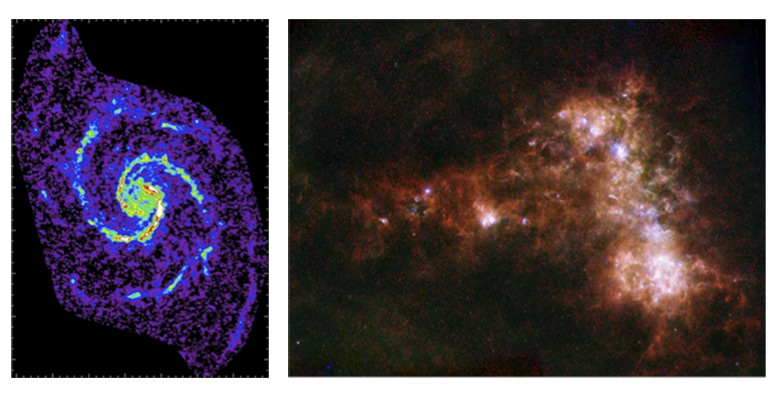
Figure 1. (Left) Distribution of molecular gas (Giant Molecular Clouds - GMCs) in the Whirlpool galaxy M51 (Credit: Koda et al. 2009, ApJL, 700, 132). (Right) The Small Magellanic Cloud observed from the Herschel Space Observatory. (Image credit: ESA/NASA/JPL-Caltech/STScI)
Multi-line analysis using diffuse to dense gas tracers will become possible with the superb sensitivity and wideband capabilities of ALMA. The CO lines (including its isotope) will be observed from J = 1-0 to J = 9 –8 (except for J = 5-4), and different J transitions from dense gas tracers such as HCN, HCO+ lines will also be available. The atomic carbon ([CI]) line will be observed in the 400 and 800 GHz bands. Molecular lines such as SiO and CH3CN may quantify the properties and location of the shocks in starbursting regions, merging galaxies, or in barred potential. Line surveys of fainter and exotic lines are also extremely important, and the chemical analysis of the ISM will be an integral part of ALMA in nearby galaxy studies.
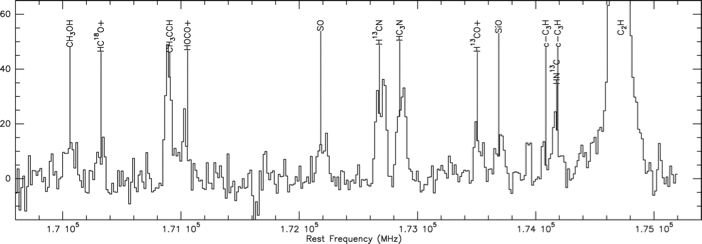
Figure 2. 2 mm spectral line survey toward the nuclear region of NGC253 (Martin et al., 2006, ApJS, 164, 450)
The power of galactic nuclei spans a continuous range covering quasars, AGN, radio galaxy nuclei, IR luminous and starburst galaxies, and the more modest activity in nearby galaxies and the center of the Milky Way. While discs around massive black-holes are suspected to be the source of power for AGNs and quasars, it is clear that huge luminosities can be generated by starbursts triggered by galaxy-galaxy interactions and mergers that drive large quantities of gas towards the central regions. ALMA will provide much more light on these problems. It will allow us to determine the masses and kinematics of optically obscured galactic nuclei with a resolution of a few parsecs and image the distributions of a variety of molecules.
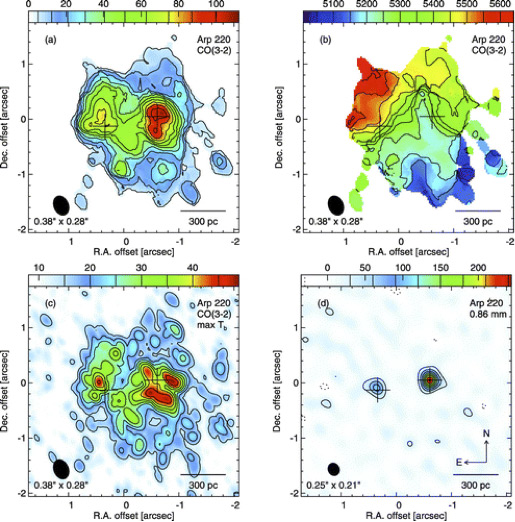
Figure 3. SMA CO(3-2) and 0.86mm emission in the nearby ULIRG Arp220 (Sakamoto et al., 2008, ApJ, 684, 957)
A key aspect of ALMA’s capabilities is its high sensitivity on the longest baselines. This will allow observations of a statistically significant sample of galactic nuclei and to resolve structures of a few parsecs in nearby nuclei and of ≈ 100 pc in luminous galaxies at redshifts of 0.1-0.2. Molecular imaging with ALMA will enable us to image directly a parsec-scale molecular torus in a large number of galaxies, and to determine accurately the column densities and optical depths of the torus. These observations are important to view directly how the gas loses sufficient angular momentum to bring it down to the scales where it can feed and/or obscure the AGN, testing and refining the unified models for AGN.
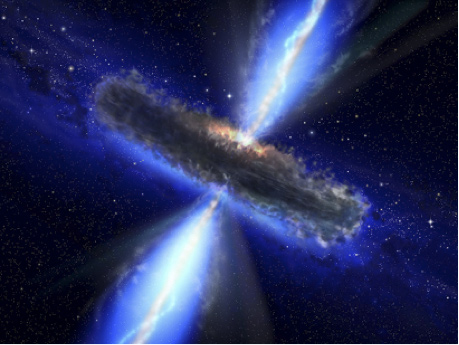
Figure 4. Artist's impression of an Active Galactic Nucleus (Copyright: ESA/NASA, the AVO project and Paolo Padovani)
Finally, our own Galactic center provides a unique opportunity to study at very high spatial resolution the physical processes occurring in a galactic nucleus, in particular the nature of the molecular cloud population and the physical phenomena occurring in the vicinity of a massive black hole. The central region of our galaxy hosts a crowded environment with strong shear, magnetic fields and frequent cloud-cloud collisions. At the dynamical center lies Sgr A*, a strong radio continuum source and the best black hole candidate in the known Universe. ALMA’s southern hemisphere location makes the Galactic center a key science target. Such observations are essential if we are to understand the nature of the ISM in the Galactic center and its star forming properties. Polarization measurements will also be extremely important in establishing the magnetic field geometry within the molecular gas – strong fields are thought to permeate much of the nuclear region.
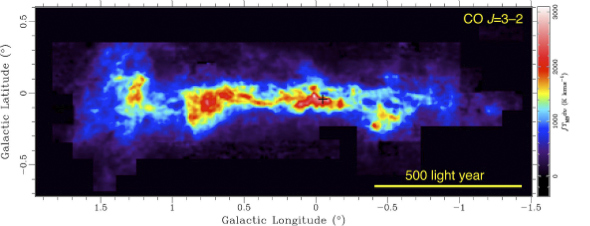
Figure 5. Spatial distribution of molecular gas at the center of the Milky Way Galaxy in CO(3-2). The black cross mark indicates the position of “Sagittarius A*”. (Credit: Keio University) (Oka et al. 2012, ApJS, 201, 140)
Reference: ESO/ALMA document “Science with ALMA”
Starbursts and AGN
Using ALMA Band 3 to observe the CO(1-0) emission, Bolatto et al. (2013) discovered a molecular structure resembling a starburst driven wind in the nearby starburst galaxy NGC 253. The sensitivity of the ALMA data is an order of magnitude better than previous 12CO image of NGC253, allowing them to study the detailed structure of the molecular gas surrounding the Ha filaments. The molecular outflow rate determined from these observations is 3 – 9 Msun/yr, implying a ratio of mass-outflow rate to star-formation rate of at 1 – 3. This suggests that the star formation activity in the galaxy is regulated by the starburst-driven wind and will therefore determine the final stellar content.

Fig. 7 Starburst-driven outflow in NGC 253 (CREDT: Alberto Bolatto, University of Maryland)
Fathi et al. (2013) analyzed the ALMA Band 7 data of NGC 1097, a Seyfert 1 galaxy that is known to contain a central AGN and a starburst ring. The ALMA data suggests, after modeling the kinematic structure of the HCN(4-3) line, that dense gas is streaming down to 40pc distance from the supermassive BH in this galaxy. The dense gas is confined to a very thin disk, and they derive a dense gas inflow rate of 0.09 Msun/yr at 40pc radius. Izumi et al. (2013) used the HCN, HCO+ and CS lines to characterize the physical condition of gas, and found that the high-J lines (J = 4–3 and 3–2) are emitted from dense (104.5 cm−3≤nH2 ≤106 cm-3) and warm (70K≤Tkin≤550K) regions. They also suggest that the observed enhanced HCN emission arises from “high temperature chemistry” rather than pure gas phase PDR/XDR chemistry. A detailed investigation of the molecular lines detected in the 3mm band was conducted by Martin et al.
A well known Seyfert 2 galaxy NGC1068 was observed in ALMA Band 7 and 9 by Garcia-Burillo et al., with an aim to investigate the molecular fuelling and the feedback processes in this galaxy. They find that the CO(3-2) emission is distributed throughout the starburst ring and the bar/inter-bar region, but the dense gas tracers, HCO+, HCN, CS, are mainly found near the r~200pc circum-nuclear disk. From their kinematical analysis, they suggest a molecular outflow of dM/dt ~ 63 Msun/yr from the circum-nucler disk region. The same galaxy was observed in ALMA Band 3 by Takano et al., finding that the SO, HC3N, and CH3CN molecules are concentrated in the cicum-nuclear disk, CS and CH3OH molecules are distributed in both the cicumnucler disk and the starburst ring, and 13CO and C18O are distributed along the starburst ring.
References: Bolatto, A., et al., 2013, Nature, 499, 450; Fathi, K., et al., 2013, ApJ, 770, 27; Izumi, T., 2013, PASJ, 65, 100; Martin et al., 2015, A&A, 573, 116; Garcia-Burillo et al., 2014, A&A, 567, 125; Takano et al., 2014, PASJ, 66, 75
Merging galaxies and ULIRGs
The nearest face-on galaxy merger, the Antennae galaxy NGC4038/4039, is an ideal target for studying how galaxy interactions affect the interstellar medium and star formation. Herrera et al. (2012) used the Science Verification data of ALMA Band 7 to study the antennae galaxies in CO(3-2) emission. Their comparison with the VLT/SINFONI H2 image revealed that the distribution of CO and H2 are closely related, and suggests that the observed variations in the H2/CO line ratio may indicate that the SGMCs are dissipating their turbulent kinetic energy at different rates. Espada et al. (2013) also studied the same data-set in detail, and found 10 molecular clumps that are associated with the tidal arm south of NGC 4039, resembling a morphology of beads on a string with an almost equidistant separation between the beads of about 350 pc, which may represent a characteristic separation scale for giant molecular associations. A high spatial resolution (0.5”) CO(3-2) image toward the overlap region of the Antennae was obtained by Whitmore et al.
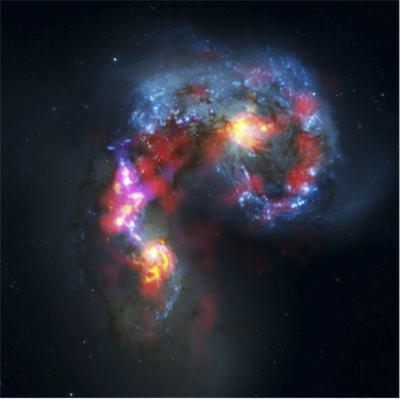
Fig. 8 ALMA (ESO/NAOJ/NRAO). Visible light image: the NASA/ESA Hubble Space Telescope
U/LIRGs are sources that show extreme IR luminosities, and are important sources to study merger triggered star formation and AGN activity. Iono et al. (2013) observed LIRGs VV114 using ALMA in dense gas tracers HCN and HCO+. They find a compact nuclear (< 200 pc) and extended (3–4 kpc) dense gas distribution across the eastern part of the galaxy pair. They found a significant enhancement of HCN (4–3) emission in an unresolved compact and broad component found in the eastern nucleus of VV 114, and suggested the presence of an AGN there. Imanishi et al. (2013) observed a LIRG NGC1614 in the same molecules, and found a velocity structure such that the northern (southern) side of the nucleus is redshifted (blueshifted) with respect to the nuclear velocity of this galaxy. Contrary to the nuclear region of VVV114, the HCN emission is weaker than HCO+, suggesting a pure starburst system. Using ALMA Band 9, the CO(6-5) line in NGC1614 (Xu et al) and in Arp220 (Wilson et al.) were observed.
References: Herrera, C., et al., 2012, A&A, 538, 9; Espada, D., et al., 2012, ApJ, 760, 25; Whitmore, B. et al., 2014, ApJ, 795, 156; Iono, D., et al., 2013, PASJ, 65, 7; Imanishi, M., et al., 2013, AJ, 146, 47; Xu et al. 2015, ApJ, 799, 11; Wilson et al., 2014, ApJL, 789, 36
Galactic Center
Using the Science Verification data, Yusef-Zadeh et al. (2013) studied the SiO emission near the central region of the Milky way. They find form the ALMA observations that the interior of the circumnuclear molecular ring is not completely filled with ionized gas but it is a site of molecular clumps and on-going star formation. They find that these clumps are not gravitationally bound, and suggesting outflows from YSOs. This would be the first time that star formation was observed so close to the galactic center.
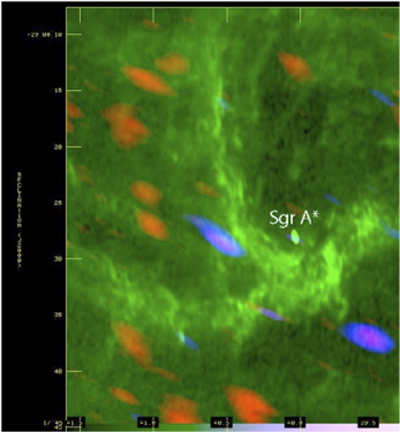
Fig. 9 A combined ALMA and Very Large Array (VLA) image of the galactic center. The supermassive black hole is marked by its traditional symbol Sgr A*. The red and blue areas, taken with ALMA, map the presence of silicon monoxide, an indicator of star formation. The blue areas have the highest velocities, blasting out at 150-200 kilometers per second. The green region, imaged with the VLA, traces hot gas around the black hole and corresponds to an area 3.5 by 4.5 light-years. Credit: Yusef-Zadeh et al., ALMA (ESO, NAOJ, NRAO), NRAO/AUI/NSF.
Referenes: Yusef-Zadeh, et al., 2013, ApJ, 767, 32
H2O masers
H2O maser traces at extreme conditions (Tk > 1000K). Hagiwara et al. (2013) presents the first detection of an extragalactic submillimeter H2O maser (321 GHz) toward the center of the Circinus galaxy, a nearby Type 2 Seyfert. They find that the 321 GHz maser occurs in a region similar to that of the 22 GHz maser.
References: Hagiwara, Y., et al., 2013, ApJ, 768, 38
